How
to Plan & Write
IELTS Advantages and Disadvantages Essays
Questions for IELTS advantages and
disadvantages essays can be worded in several different ways. Here is some typical wording that might
be used:
- What are the advantages and disadvantages of….?
- Do you think the advantages outweigh the disadvantages?
- Discuss the advantages and disadvantages and give your opinion.
It is also common for synonyms of ‘advantages’ and ‘disadvantages’ to be used, such as ‘benefits’ and ‘drawbacks’, as can be seen in this sample question.
A
lot of places in the world rely on tourism as a main source of income.
Unfortunately, tourism can also be a source of problems if it is not well-managed.
What are the advantages and disadvantages of tourism
in the modern world? Do you think that the benefits of tourism outweigh its drawbacks?
I’ll be using this
question to guide you through the process of planning and writing an IELTS advantage
and disadvantages essay later on in this lesson.
Here’s what the lesson covers:
- Understanding IELTS advantages & disadvantages essay questions
- Essay structures
Want to watch and listen? Click on this video.
Click the links to see lessons on each of these Task 2 essay writing topics.
Once you understand the process, practice on past questions. Take your time at first and gradually speed up until you can plan and write an essay of at least 250 words in the 40 minutes allowed in the exam.
The Question
IELTS advantages and
disadvantages essay questions fall into two main categories:
- Questions that ask for your opinion.
- Questions that do not require you to state your opinion.
The first part of the question will always be a statement. You will then be asked to write about both the advantages and disadvantages of the idea stated. You may also be required to state your opinion.
Here are two more sample questions for illustration. For the first one, you must give your opinion but in the second, you should not.
1. Small businesses are disappearing and being
replaced by large multinational companies.
Do the advantages of this outweigh the disadvantages?
2. Most career choices demand vocational skills or specialist knowledge. However, despite this, most schools still teach academic subjects such as history or social studies.
Discuss the advantages and
disadvantages of this?
Essay Structures
Now let’s look at two simple structures you can use to write
IELTS advantages and disadvantages essays. They're not the only possible structures
but are ones I recommend because they are easy to learn and will enable you to
quickly plan and write a high-level essay.
I’ll explain later why I’m giving you two slightly different structures.
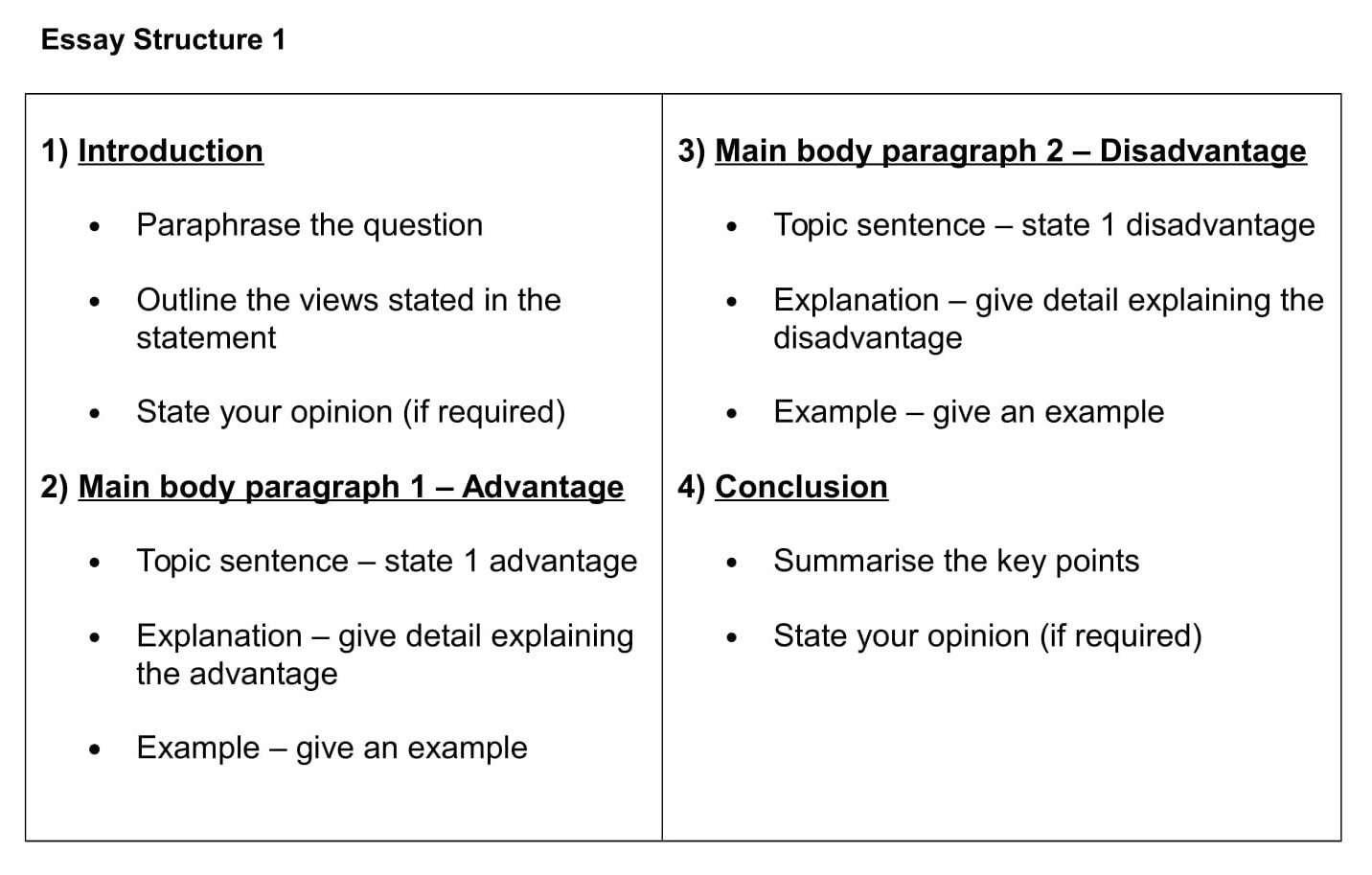
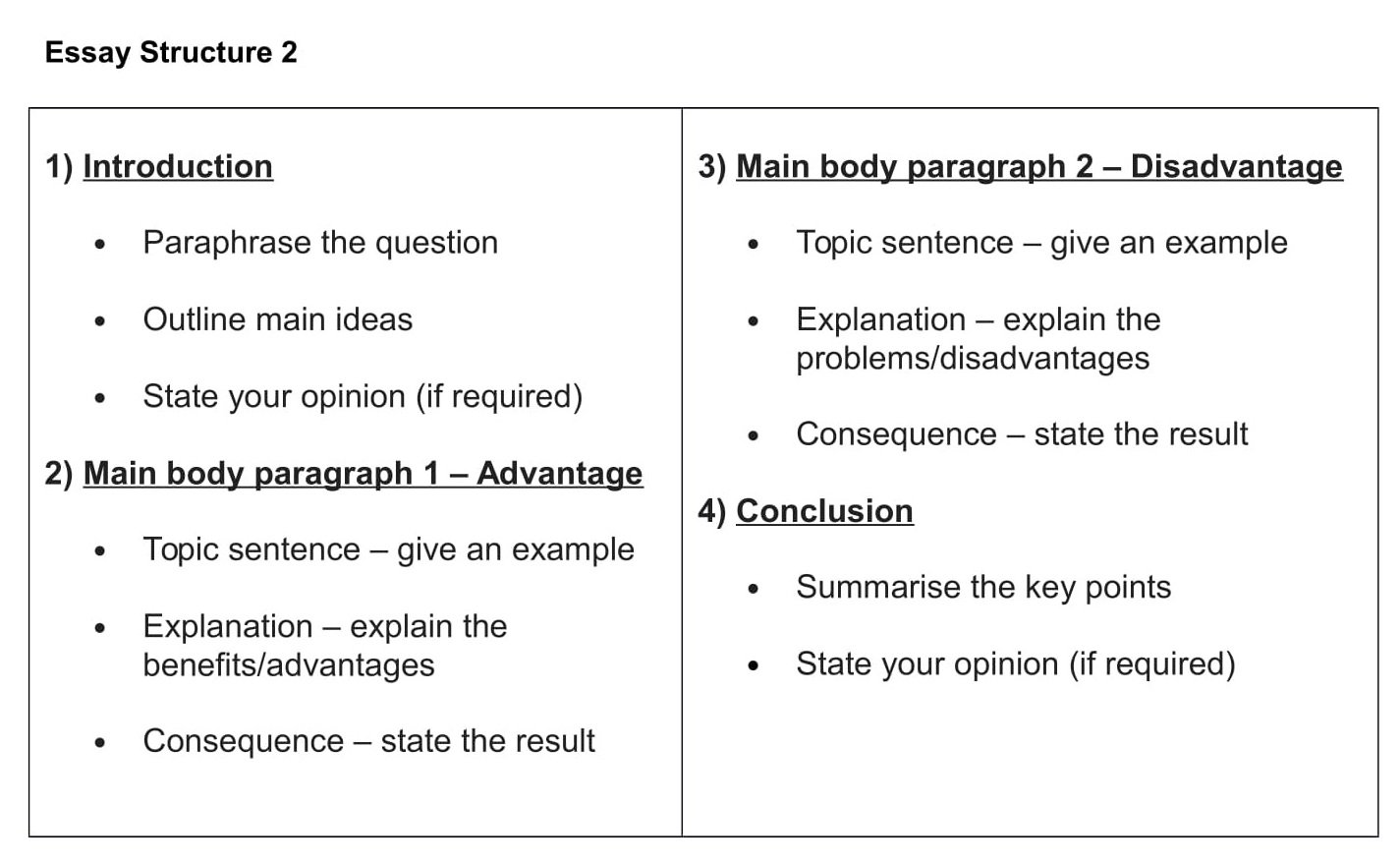
These structures will give you a well-balanced essay with 4 paragraphs.
One Advantage and Disadvantage or Two?
The question
will state 'advantages' and 'disadvantages' in the plural, that is, more than one.
However, it is acceptable to write about just one.
This should give you an essay of just over the minimum 250 words. To write about two advantages and disadvantages will require you to write nearer 400 words which are a lot to plan and write in the 40 minutes allowed.
It is better to fully develop one advantage and one disadvantage than ending up with your second idea missing an explanation or an example because you run out of time, but you can write about two if you feel able to or more comfortable doing so.
Having said that, using essay structure 2, where you start with the examples, will enable you to easily add more than one advantage and disadvantage without having to write many more words.
It will be more suitable for some questions than others so bear this in mind when you're writing practice essays and try out both structures.
I’m going to use essay structure 2 to show you step-by-step how to write an IELTS advantage and disadvantages essay. I’ll also give you a model answer using essay structure 1 so that you can compare the two.
How To Plan
IELTS Advantages and Disadvantages Essays
The planning process only takes around 5 minutes but it is essential as it will save you time overall and will result in a far better essay and thus, higher marks. There are the 3 things you need to do:
- Analyse the question
- Generate ideas
- Identify vocabulary
# 1 Analyse the question
Analysing the question will ensure that you answer it fully. It’s quick and easy to do. You just need to identify 3 different types of words:
- Topic words
- Other keywords
- Instruction words
Topics words are the ones that identify the general subject of the question and will be found in the statement part of the question.
Here is the question we’re going to be working on. I’ve highlighted the topic words in blue.
A lot of places in the world rely on tourism as a main source of income. Unfortunately,
tourism can also be a source of problems if
it is not well-managed.
What
are the advantages and disadvantages of tourism
in the modern world? Do you think that the benefits of tourism
outweigh its drawbacks?
So, this
question is about ‘tourism’.
Many people do this first step of the process and then write about the topic in general. This is a serious mistake and leads to low marks for task achievement.
What we need to do now that we know the general topic, is to understand exactly what aspect of tourism we're being asked to write about.
The other keywords in the question tell you the specific topic your essay must be about.
A lot of places in the world rely on
tourism as a main source of income.
Unfortunately, tourism can also be a source of problems
if it is not well-managed.
What
are the advantages and disadvantages of tourism in the modern world? Do you
think that the benefits of tourism outweigh its drawbacks?
By highlighting these words, it’s easy to see that you are being asked to write about the conflicting issues of tourism being ‘a main source of income’ in many places, yet also being ‘a source of problems’.
Your essay must only include ideas relevant to this aspect of tourism.
The instruction words are the question itself. They tell you exactly what to include in your essay.
A lot of places in the world rely on
tourism as a main source of income. Unfortunately, tourism can also be a source
of problems if it is not well-managed.
What
are the advantages and disadvantages of tourism in the modern world? Do
you think that the benefits of tourism outweigh its drawbacks?
Here, we are required to write about:
- The advantages of tourism in relation to income generation.
- The disadvantage of tourism in relation to problems it can cause.
- Our opinion as to whether the advantages
outweigh the disadvantages.
Note the use of the synonyms ‘benefits’ and ‘drawback’ in the second sentence of the question.
# 2 Generate ideas
The next task is to generate some ideas to write about.
There are several different ways to think up ideas. I cover them fully on the IELTS Essay Planning page.
I’m going to demonstrate two of them for you here – the ‘friends technique’, which is suitable for most IELTS essays, and the ‘example method’, which perfectly fits essay structure 2.
The ‘friends technique’ is the method I generally prefer as it allows you to take a step back from the stress of the exam situation and think more calmly.
Here’s how it works. Imagine that you are chatting with a friend over a cup of coffee and they ask you this question. What are the first thoughts to come into your head? Plan your essay around these ideas.
Doing this will help you to come up with simple answers in everyday language rather than straining your brain to think of amazing ideas using high-level language, which isn’t necessary.
Here are my ideas using the friends technique:
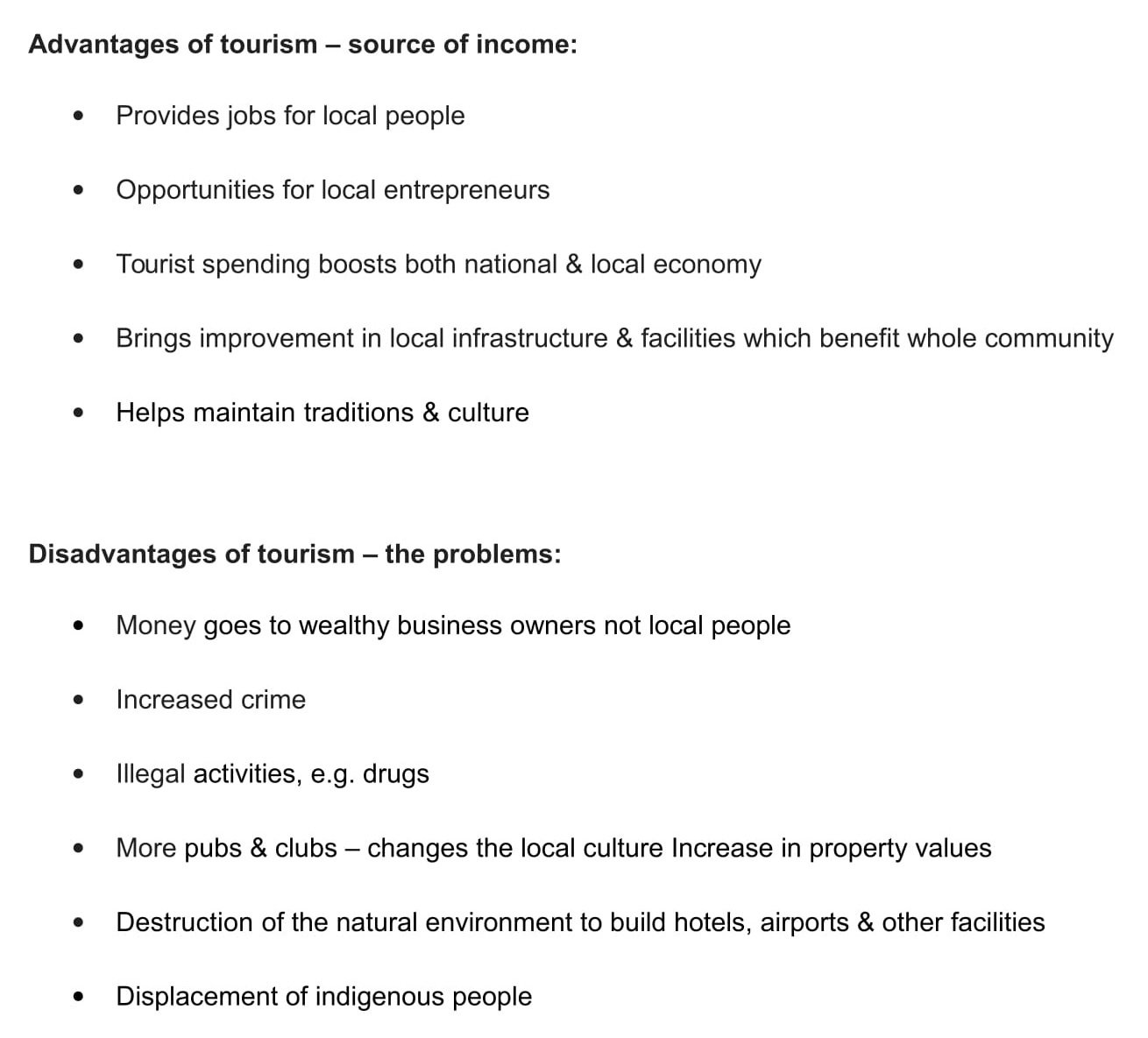
There are far too many ideas here to include in an essay of just over 250 words. Think up a few then pick one advantage and one disadvantage that you think you can develop well.
With the 'example method', on the other hand, you start by thinking of specific examples related to the question. They can come from your own experience or be something you’ve read or heard about. These examples will generate ideas that will become the main points of your essay.
It works particularly well for the model question I’ve selected for this lesson which is why I’ve included the second essay structure.
Here are my ideas using the examples technique:
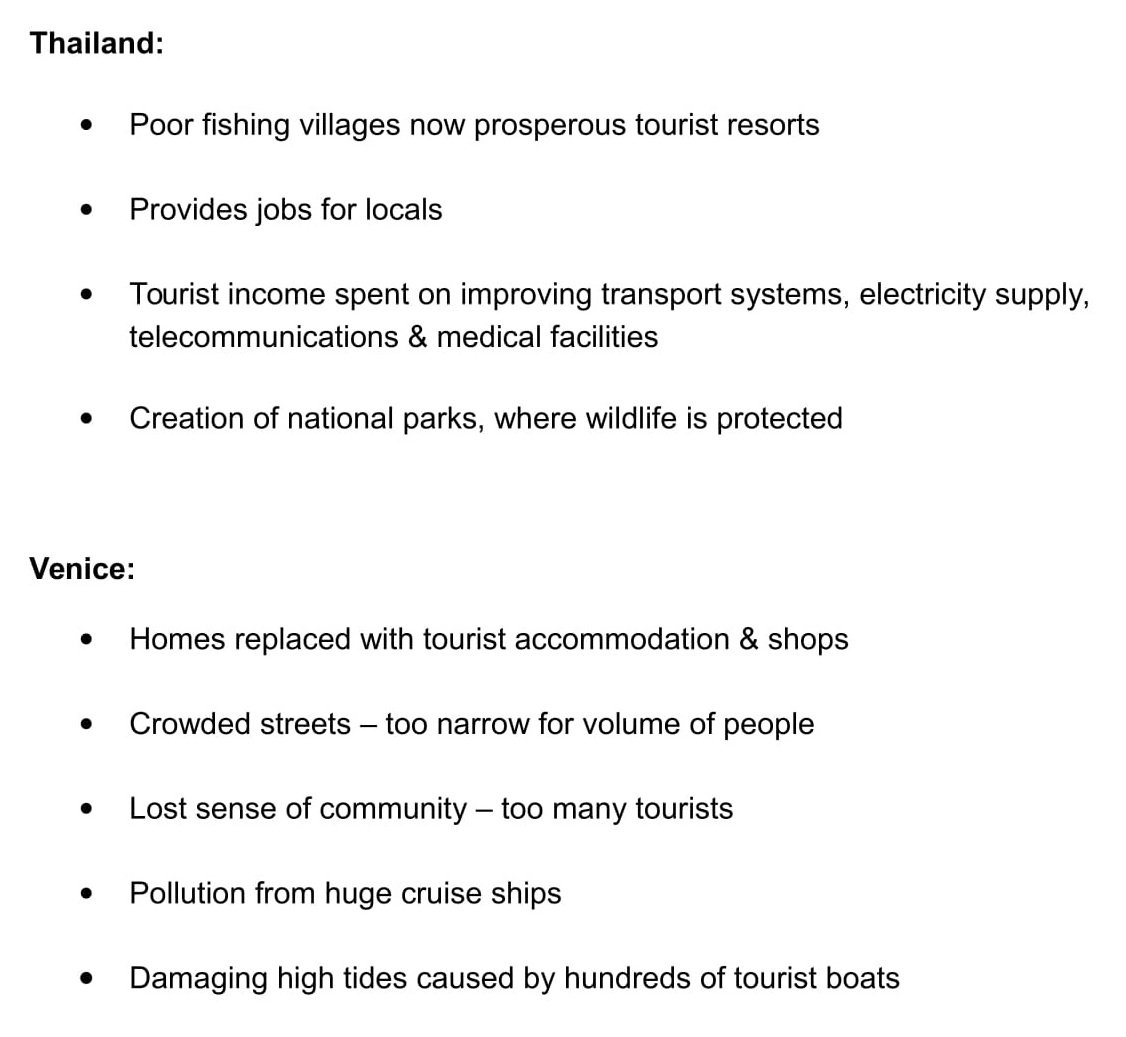
Now that we have some ideas, we’re almost ready to start writing our IELTS advantages and disadvantages essay, but first, we have one more task to do.
# 3 Vocabulary
During the planning stage, quickly jot down some vocabulary that comes to mind as you decide what you're going to write about, especially synonyms of key words. This will save you having to stop and think of the right language while you’re writing.
Writing
an IELTS Advantages and Disadvantages Essay
We’re ready to begin writing
our essay. For the first model answer, I’m going to take you step-by-step
through essay structure 2. I’ll then give you a model answer for essay
structure 1.
Here’s a reminder of the question and the essay structure.
A lot of places in the world rely on
tourism as a main source of income. Unfortunately, tourism can also be a source
of problems if it is not well-managed.
What
are the advantages and disadvantages of tourism in the modern world? Do you
think that the benefits of tourism outweigh its drawbacks?

We’ll now start work on the introduction.
How To Write an Introduction
The introduction to an
IELTS advantages and disadvantages essay should have a simple 2 or 3 part
structure:
- Paraphrase the question
- Outline the main ideas
- State your opinion (if required)
Our tourism question asks
for our opinion so our introduction will have 3 parts.
1) Paraphrase the question
Start your introduction by paraphrasing the question statement.
Question: A lot of places in the world rely on tourism as a main source of income.
Unfortunately, tourism can also be a source of problems if it is not well-managed.
Paraphrased question:
Although holidaymakers contribute hugely to the economies of many popular destinations, the influx of tourists can also cause serious issues.
Note my use of synonyms for some of the key words. It’s fine to repeat one or two words if you can't think of suitable synonyms. Above all, your language must sound natural.
2) Outline statement
Now we need to
add a statement where
we outline the main points that we’ll be covering in the rest of the essay,
that is, an advantage of tourism and a disadvantage of tourism.
Here are the two main ideas I’ve chosen to write about:
- Advantage – Poor areas are now prosperous tourist resorts
- Disadvantage – Displacement
of local people
Outline statement:
This essay will demonstrate how tourism can transform the economy of poor areas but will also show that this can lead to such problems as the displacement of local people.
3) Opinion statement
The question also asks for our opinion and it’s essential that we include it in the introduction.
Opinion statement:
Whilst acknowledging that there are drawbacks, the essay will argue that the advantages of the tourist industry outweigh the disadvantages.
So, let’s bring the three elements of our introduction together.
Introduction

This introduction achieves three important functions:
- It shows the examiner that you understand the question.
- It acts as a guide to the examiner as to what your essay is about.
- It also helps to keep you focused and on track as you write.
The two ideas in your introduction will become your two main body paragraphs.
Main body paragraph 1 – Poor
areas are now prosperous tourist resorts
Main body paragraph 2 – Displacement of local people
How To Write Main Body Paragraphs
Main body
paragraphs in IELTS advantages and disadvantages essays written using structure 2, should
contain 3 things:
- Topic sentence – give an example
- Explanation – explain the benefits/advantages
- Consequence
– state the result
Main Body Paragraph 1
The topic
sentence summarises the main idea of the paragraph. It plays an
important role in ensuring that your ideas flow logically from one to another.
It does this by acting as a signpost for what is to come next, that is, what
the paragraph will be about.
If you maintain a clear development of ideas throughout your essay, you will get high marks for task achievement and cohesion and coherence.
In this instance, the topic sentence will introduce our first example, for which I’ve chosen Thailand.
- Main idea – Poor areas are now prosperous tourist resorts
- Example
–
Thailand
Topic sentence:
One country that has experienced a significant economic boost from tourism is Thailand.
Next, we must write an explanation sentence that states the main point of our example.
Explanation sentence:
Over the past 50 years, many of its small fishing villages, where people often struggled to make a living, have been developed into thriving holiday destinations.
Finally, we explain the consequence or result of the situation. This is where we give an example of one specific advantage. It is better to pick one and develop it than to just add a long list.
Consequence:
With all the hotels, restaurants, shops and other tourist facilities that have been developed, there are now enough jobs for everyone and the general standard of living has greatly increased. Many local people have spotted new business opportunities and become entrepreneurs which has further diversified the economy.
That’s the 3
parts of our first main body paragraph complete. Here’s the finished paragraph.

We’ll now
follow the same process for our second main body paragraph.
Main Body Paragraph 2
Main idea – Displacement of local
people
Example – Venice
First, we write the topic sentence to summarise the main idea.
Topic sentence:
In Venice, on the other hand, the huge popularity of the beautiful canals and stunning architecture with visitors from around the world has had a negative impact on local residents.
Now for
the explanation sentence that states the main point
of our example.
Explanation sentence:
The growing need for tourist accommodation, places to eat and shops has forced many people from their homes to make way for this new development.
Finally, a
specific example to explain
the consequence.
Consequence:
Not only have these people suffered by having to move away from their family and friends but the situation has also resulted in a lost sense of community in the worst affected areas.
That’s the 3 parts of our second main body paragraph complete. Here’s the finished paragraph.

Now we need a conclusion and our IELTS advantages and disadvantages essay is done.
How To Write a Conclusion
The
conclusion is a summary of the main points in your essay and can generally be
done in a single sentence. It should never introduce new ideas.
If you're below the minimum 250 words after you’ve written your conclusion, you can add a prediction or recommendation statement.
Our essay is already near the minimum word limit so we don’t need this extra sentence but you can learn more about how to write a prediction or recommendation statement for IELTS advantages and disadvantages essays on the Task 2 Conclusions page.
The conclusion is the easiest sentence in the essay to write but one of the most important.
A good conclusion will:
- Neatly end the essay
- Link all your ideas together
- Sum up your argument or opinion
- Answer the question
If you achieve this, you’ll improve your score for both task achievement and cohesion and coherence which together make up 50% of the overall marks. Without a conclusion, you’ll score below band 6 for task achievement.
You can start almost any final paragraph of an IELTS advantages and disadvantages essay with the words:
- In conclusion
or
- To conclude
Now all you need to do is briefly summarise the main ideas into one sentence.
Here’s a top tip. Go back and read the introduction to the essay because this is also a summary of the essay. It outlines what you are going to write about.
To create a great conclusion, you simply have to paraphrase the introduction.
Introduction:

Here's the same information formed into a conclusion:

That’s it. We’ve completed our advantages and disadvantages essay. Here it is with the 4 paragraphs put together.
Question:
A lot of places in the world rely on tourism as a main source of income. Unfortunately, tourism can also be a source of problems if it is not well-managed.
What are the advantages and disadvantages of tourism in the modern world? Do you think that the benefits of tourism outweigh its drawbacks?
Finished IELTS advantages and disadvantages essay.
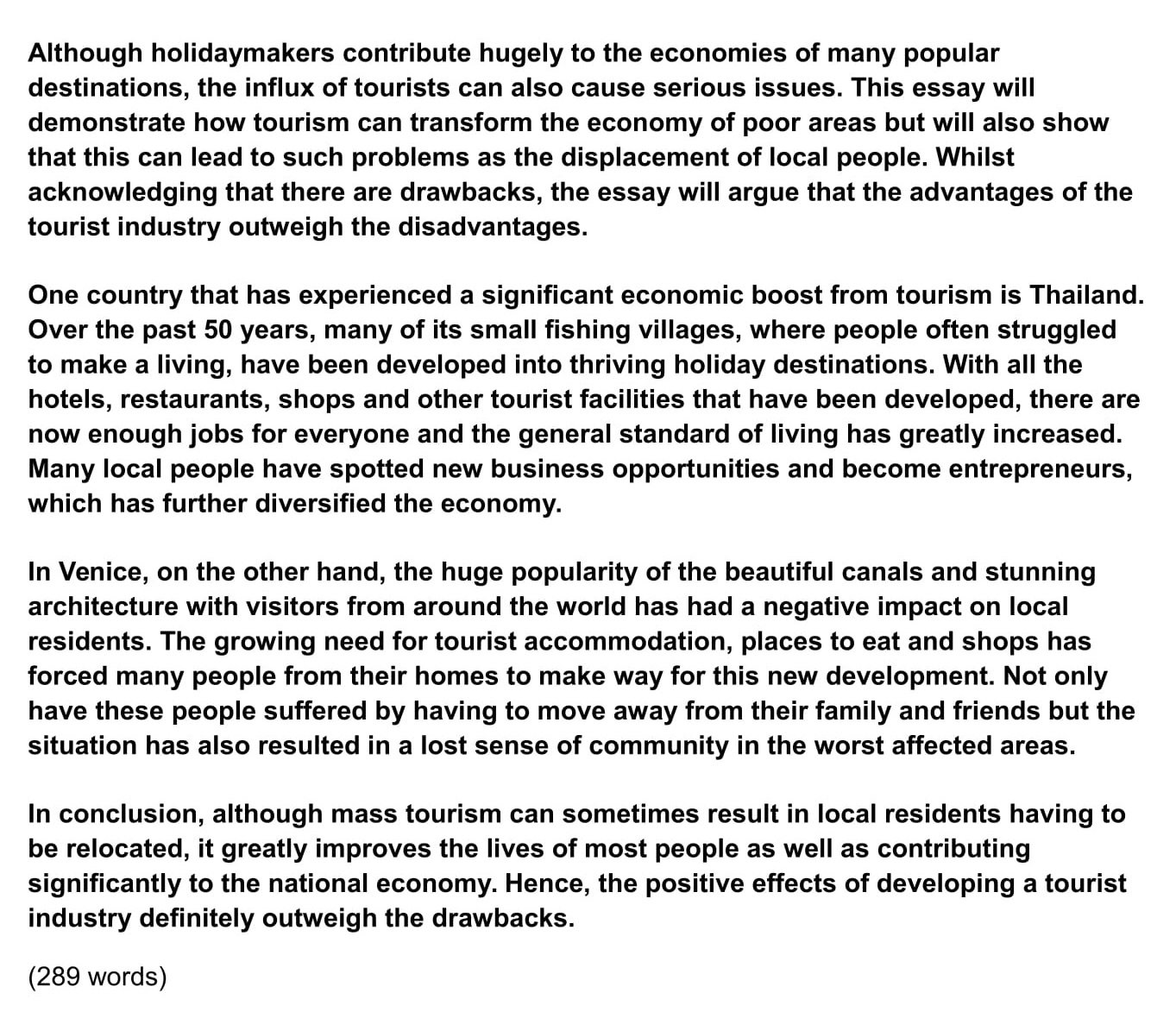
Go through this lesson as many times as you need to in order to fully understand it and put in lots of practice writing IELTS advantages and disadvantages essays from past exam questions. Practice is the only way to improve your skills.
Example
IELTS Advantages and Disadvantages Essay
for Structure 1
Now, here’s a
model answer for essay structure 1. First, a reminder of the structure and the
ideas I generated using the friends technique.

Ideas generation - Friends technique
I’ve underline the ideas I’ve chosen to write about
in this second essay:
Advantages
of tourism – source of income:
- Provides jobs for local people
- Opportunities for local entrepreneurs
- Tourist spending boosts both national & local economy
- Brings improvement in local infrastructure & facilities which benefit whole community
- Helps maintain traditions & culture
Disadvantages of tourism – the problems:
- Money goes to wealthy business owners not local people
- Increased crime
- Illegal activities, e.g. drugs
- More pubs & clubs – changes the local culture
- Increase in property values
- Destruction of the natural environment to build hotels, airports & other facilities
- Displacement of indigenous people
The essay
See if you can identify the different parts of the essay and how I have developed them.
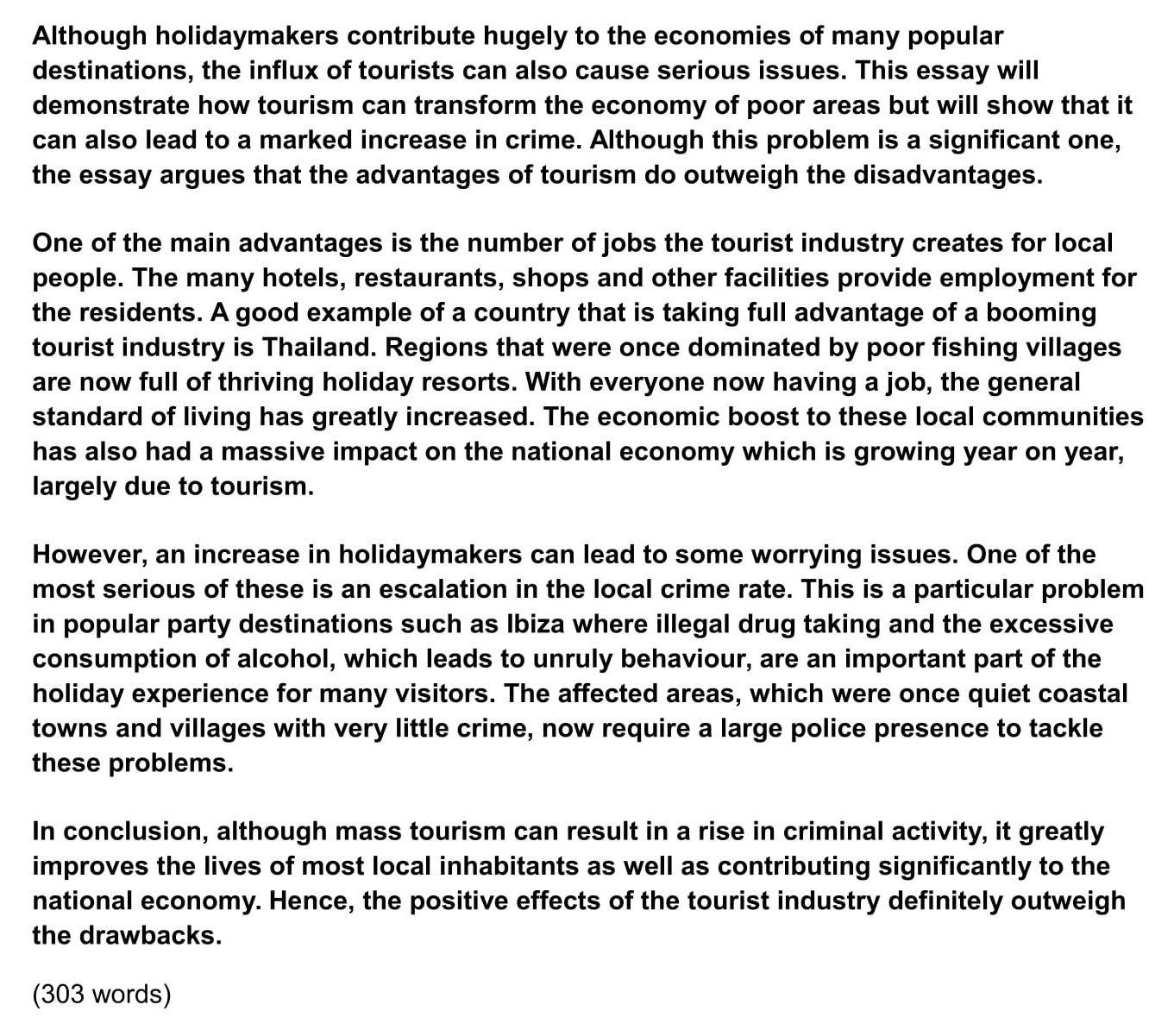
That's it. Now it's time for you to get practicing.
Like this page?
More Help With IELTS Advantages and Disadvantages Essays
& Other Task 2 Essays
Task 2:
IELTS Writing Task 2 – The format, the 5 question types, the 5 step essay writing strategy & sample questions. All the key information you need to know.
The 5 Types of Task 2 Essay – How to recognise the 5 different types of Task 2 essays. 15 sample questions to study and a simple planning structure for each essay type.
Understanding Task 2 Questions – How to quickly and easily analyse and understand IELTS Writing Task 2 questions.
How To Plan a Task 2 Essay – Discover why essay planning is essential & learn a simple 4 step strategy, the 4 part essay structure & 4 methods of generating ideas.
How To Write a Task 2 Introduction – Find out why a good introduction is essential. Learn how to write one using a simple 3 part strategy & discover 4 common mistakes to avoid.
How To Write Task 2 Main Body Paragraphs – Learn the simple 3 part structure for writing great main body paragraphs and also, 3 common mistakes to avoid.
How To Write Task 2 Conclusions – Learn the easy way to write the perfect conclusion for a Task 2 essay. Also discover 4 common mistakes to avoid.
Task 2 Marking Criteria – Find out how to meet the marking criteria in Task 2. See examples of good and poor answers & learn some common mistakes to avoid.
The 5 Task 2 Essay Types:
Step-by-step instructions on how to plan & write high-level essays. Model answers & common mistakes to avoid.
Advantages & Disadvantages Essays
Other Related Pages
IELTS Writing Test – Understand the format & marking criteria, know what skills are assessed & learn the difference between the Academic & General writing tests.







